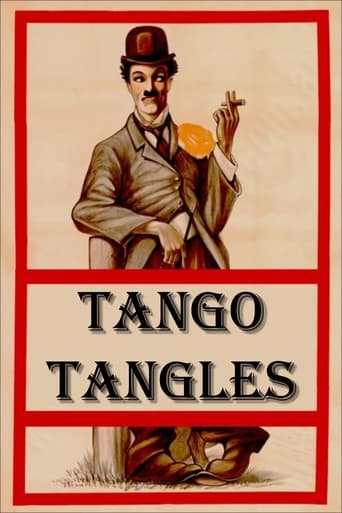mymangodfrey
During his year at Keystone, when he rose from "anonymous vaudevillian" to "America's most beloved movie star" ("world's most beloved movie star" would take another year), Chaplin bridled against the improvised-boxing-and-frantic-running style of comedy that Mack Sennett pioneered.When it worked, this improvisational style could be joyful and amusing. When it didn't, the movies seemed lazily constructed, empty and chaotic. Tango Tangles, despite its historical interest (one of few shorts showing a young and very handsome Chaplin out of his Tramp getup), and despite the always-welcome presence of Fatty Arbuckle, is one of the shapeless failures.There's no movie here: just a bunch of great silent comedy stars goofing around, and not in an inspired way.
tavm
In this short, another one of the early ones Charlie Chaplin made for Mack Sennett, he's clean shaven and is nothing like his Little Tramp character. Well, except here he's just as drunk as you'd expect him to be in these early efforts. His beginning scenes are quite amusing as he seems to be at a real dance hall happening as he tries to woo some ladies and keeps slipping and tripping himself. But all that happens afterwards results in some nonsense about fighting over a pretty girl that happen to be also pursued by musicians Ford Sterling and Roscoe "Fatty" Arbuckle. As a result, I didn't think the rest was all that funny and in fact was repetitious though it was nice to see Arbuckle do some falls himself. So on that note, Tango Tangles is worth a look and nothing else.
Michael DeZubiria
In Chaplin's first handful of short comedies, there is a very clear pattern of experimentation going on as he discovers where his real talent lies and while the personality of the beloved Tramp evolves and makes itself known. In Tango Tangles, or Charlie's Recreation, we see a bit of a digression as not only does Chaplin's character revert back into the 'obnoxious drunk' half of his on screen persona, but is also overshadowed by the clearly talented and, in this film at least, almost equally large screen presence of Ford Serling.Serling has been credited by some users as deserving at least some credit for inspiring some aspects of Chaplin's character, which I can accept, because the motions and overblown mannerisms are similar to some of Chaplin's later work, although I think it's important to point out that if Chaplin did learn from Serling, he most certainly saw his technique and improved it, maybe even perfected it.At the beginning of the film, it is clear that Serling has an intense presence, but as the film goes on, the infancy of screen acting also becomes apparent. It seems here that actors did not know where to stop when flinging themselves about in the outrageously overblown antics that must have been common in slapstick comedy for the stage. They slap each other in the face and then stumble about in a bizarre state of semi-consciousness, wobbling on their feet while their arms swing limply, eyes bulging and head bouncing from side to side like a superball in a box, before eventually falling over backwards and flinging their legs up over their head far enough so that their toes touch the ground behind them.Not that this is all bad comedy, just a sign of how different the things were that made people laugh in 1914 compared to today, as well as a curious look at the development of slapstick comedy for the screen.As far Chaplin's performance, it is also clear that the Tramp was still in the future, as he appears in this film without a mustache and therefore looking entirely like someone else. As I mentioned, he once again plays a belligerent drunk, stumbling around and callously punching and pushing people and throwing things at them as he staggers about the set, also in a bizarre state of semi-consciousness. Fatty Arbuckle also puts the majority of his talents on hold to star in this short, as he, Chaplin, and Serling all compete viciously for the affections of the hat girl, with what probably used to be hilarious results. By now, the film is one of the lesser of Chaplin's very early films, but remains an interesting milestone on his way to making his own far superior films.
MartinHafer
This is a film from Chaplin's first year in films. During this VERY hectic year, he churned out film after film after film for Keystone Studios and the quality of the films are, in general, quite poor. That's because the character of "the Little Tramp" was far from perfected and the films really had no script--just the barest of story ideas. While some Chaplin lovers might think this is sacrilege, all these movies I have seen are pretty lousy. Yes, there are some cute slapstick moments but barely any plot--absolutely NOTHING like the Chaplin we all came to love in his full-length films of the 20s and 30s.As stated above, Charlie does not sport his usual mustache. The movie is about jealousy and consists of lots of people pushing and punching each other--that's pretty much it!


